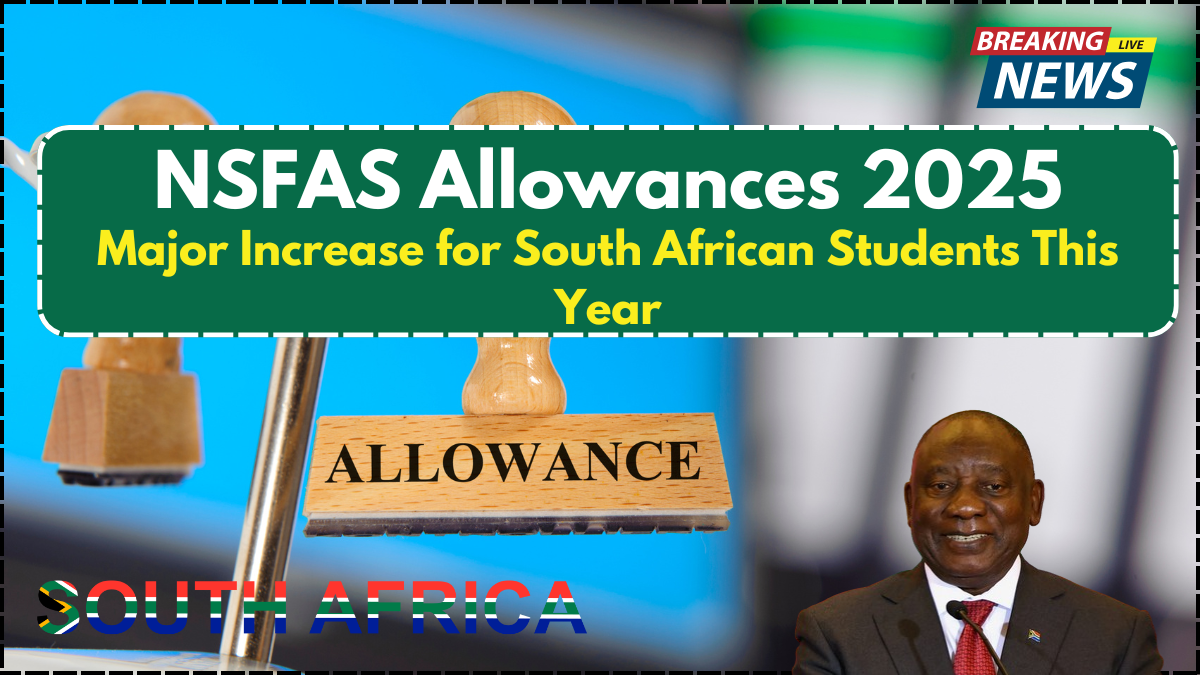In May 2025, the National Student Financial Aid Scheme (NSFAS) introduced a revamped financial support structure for South African students enrolled at public universities and Technical and Vocational Education and Training (TVET) colleges. These changes reflect an urgent response to inflation, the rising cost of student living, and feedback from educational stakeholders. With improved coverage across accommodation, transportation, meals, and learning tools, NSFAS aims to reduce financial burdens and increase student retention and performance.

Breakdown of 2025 NSFAS Allowances
The revised allowance structure expands funding categories to provide more tailored support for different student needs. Below is a detailed table outlining the 2025 NSFAS allowances:
| Allowance Category | Details | 2025 Amount/Notes |
|---|---|---|
| Accommodation | Varies by institution and housing type | Institution-capped |
| Living Allowance | For students in non-institutional/private housing | Covers groceries, toiletries, etc. |
| Learning Materials | For textbooks, digital tools, and course-specific resources | Varies by academic program |
| TVET College Allowance | Annual support for enrolled TVET students | Increased from R10,000 to R14,600 (46%) |
| University Payments | Disbursed through universities | Ongoing delays due to legal challenges |
| TVET Payments | Sent directly to students’ bank accounts | Fast-tracked and operational |
Why the Increase? Government’s Rationale
NSFAS Administrator Freeman Nomvalo and Deputy Minister of Higher Education, Dr. Nobuhle Nkabane, confirmed that the adjustments aim to protect vulnerable students amid economic instability. This year, TVET students benefit most, receiving a 46% rise in allowances, acknowledging their greater financial exposure. In contrast, university students receive a modest 4% increase to align with CPI-linked inflation adjustments.
Accommodation Support in Detail
Accommodation allowances are now more differentiated:
- Students in institution-owned or leased housing receive a capped annual subsidy.
- Those in private accredited housing qualify for a comparable capped rate.
- Institution-catered residences combine room and board into a bundled allowance.
- Health sciences students benefit from 12-month coverage due to extended program timelines.
Living Allowance for Daily Essentials
This is exclusive to students living in private or off-campus accommodation and helps cover basic living costs. However, it is not available to distance learners taking fewer than 60 academic credits. Students residing at home are ineligible for this allowance and instead receive a transport allowance.
Transport vs. Housing Support
Students qualify for either an accommodation or transport allowance based on where they live:
- If staying at home, they receive a transport allowance to support daily commuting.
- Those in institution-approved housing are granted accommodation funding.
Learning Materials Support
NSFAS provides funding for essential learning materials including textbooks, laptops, and course-related software or equipment. The amount is customized based on the academic discipline and institutional requirements. This helps level the playing field for students across high-resource and low-resource programs.
NSFAS Payment System Updates as of May 2025
University Students
Despite initial plans for a central banking system, legal constraints have delayed full implementation. As of May 2025, university students continue to receive allowances through institutional payment systems, with February 2025 targeted for the completion of pending disbursements.
TVET College Students
TVET college students now benefit from direct payments into their personal bank accounts. This method significantly reduces processing time and avoids issues with third-party intermediaries.
Funding Validation and Application Status
Nearly 800,000 students have been conditionally approved for 2025 funding. However, payment depends on successful registration verification. NSFAS will only disburse allowances once institutions confirm student enrollment.
Steps to Track Application Status:
- Go to NSFAS official website.
- Login to your myNSFAS account.
- Enter your registered email and password.
- Click on “Track Application Status.”
Future Outlook for Student Funding
This updated allowance structure underscores NSFAS’s continued evolution toward a student-first funding model. The significant uplift for TVET colleges is a step toward parity with university funding, and ongoing improvements in payment systems are expected throughout 2025. While full centralization is still pending, the direction remains clear: better support, less red tape, and greater accountability.
FAQs
What are the new NSFAS allowances for 2025?
The revised structure includes increased support for accommodation, daily living, learning materials, and a major boost in the TVET annual allowance to R14,600.
How are TVET payments handled in 2025?
TVET students now receive direct bank deposits, streamlining the process and reducing delays.
When will university students get their payments?
University student disbursements are ongoing, with full payments expected to resume post-verification in February 2025.
Is the living allowance available to all students?
No, it’s limited to students in private or non-institutional housing and excludes distance learners with less than 60 credits.
What if my NSFAS status is pending?
Log into your myNSFAS portal and use the tracking tool. Payments are made only after institutions confirm your registration.
Click here to know more.


